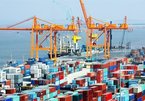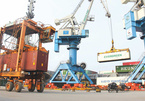 |
| Different from many other markets, Vietnam’s economy is still expected to grow substantially. Photo: Le Toan |
The Central Institute for Economic Management (CIEM), the government’s leading think-tank under the Ministry of Planning and Investment (MPI), has released two fresh scenarios on Vietnam’s economic growth for this year, based on analysis of the poor global economic performance being hit seriously by the pandemic and the health of the domestic economy which grew by only 1.81 per cent – the lowest six-month growth rate over the past 12 years.
Specifically, the Vietnamese economy may climb 2.1 per cent under the first scenario, and 2.6 per cent under the second scenario. These rates are lower than the government’s expected 3-4 per cent this year, and also much lower than the National Assembly’s previous target of 6.8 per cent.
Prime Minister Nguyen Xuan Phuc has requested all ministries, governmental agencies, and localities to make all possible efforts to reach 3-4 per cent growth, with an aim to ensure macro-economic stability and generation of employment.
According to the General Statistics Office’s latest quarterly labour force survey released over a week ago, 30.8 million people aged 15 and over were adversely affected by COVID-19 by the end of June, including those who lost their jobs, had their working hours cut or income reduced.
The International Monetary Fund has announced its latest forecasts on global economic outlook, stating that heavy aftermath caused by COVID-19 is expected to drive many major economies to below-zero growth in 2020 and 2021, such as the global economy (-1.9 and -0.4 per cent), the US (-1.9 and 0.3 per cent), Japan (-0.6 and -0.6 per cent), the UK (-3.7 and 2.3 per cent), the Eurozone (-2.7 and 1.3 per cent), China (-0.2 and -1), India (-6.4 and -1.4 per cent), and the ASEAN-5 (-1.4 and -1.6 per cent).
“All these economies’ below-zero growth will negatively affect Vietnam’s economic growth this year because Vietnam attracted a great deal investment from these markets. They are also Vietnam’s big export markets,” said CIEM head Tran Thi Hong Minh.
Figures from the Ministry of Planning and Investment showed that as of June 20, Vietnam attracted $9.35 billion in registered capital from the US, $60 billion from Japan, $3.7 billion from the UK, over $24 billion from the Eurozone, $21 billion from China, $887.2 million from India, and $90.74 billion from the ASEAN.
In total, these markets hold 55.48 per cent of Vietnam’s total attracted registered foreign direct investment (FDI) of $377.9 billion.
In Vietnam, FDI created over 20 per cent of economic growth by late last year.
Global analyst FocusEconomics has released its latest forecast for Vietnam’s economic outlook, stating, “Looking ahead, activity should stay muted in the near term, as Vietnam’s highly open economy suffers from weak external demand. Moreover, social distancing measures will affect domestic activity.”
FocusEconomics panelists project that the economy will expand 2.6 per cent in 2020, which is down 0.3 percentage points from last month’s forecast, and 7.7 per cent in 2021.
Growth is seen slowing to a decades-low this year as the tourism, retail trade, and manufacturing sectors all reel from the impact of the coronavirus. Risks to the outlook centre on the length of the coronavirus pandemic and external demand for exports, FocusEconomics said in a statement sent to VIR.
The government is now seeking permission from the Party’s Secretariat to found a first-ever national committee on fighting economic slowdown. The committee, whose head will be the prime minister and other members will be representatives of agencies in the political system, will be in charge of studying and proposing sturdy policies in favour of enterprises and individuals, so that they can escape difficulties as soon as possible and the economy can recover soon. Other groups will also be established to specialise in supporting enterprises at this time.
In the first six months of 2020, Vietnam’s index for industrial production rose at a very low level of 2.7 per cent on-year. In this, the index for the manufacturing and processing industry, which creates 80 per cent of industrial growth, grew 4.96 per cent on-year, which is the lowest six-month increase in 2011-2020.
However, domestic industrial production has been moving onward since May, after months of despair due to the pandemic leaving businesses in the lurch.
After two months of lifting social distancing measures, the number of newly-established enterprises in June was 13,700, registered at VND139.1 trillion ($6 billion), up 28 per cent on-month in the number of enterprises and 23.4 per cent in capital.
Besides this, an MPI survey on business trends of manufacturing and processing in the second quarter showed that enterprises are expecting their performance in the third quarter to be better.
Specifically, 49 per cent of surveyed enterprises expect their performance will be better in the third quarter. Some 19.4 per cent forecast more difficult performance in the third quarter, while 31.5 per cent said their performance will be stable. VIR
Thanh Thu

Mckinsey assesses Vietnam’s economic recovery capacity
Vietnam could expect the strong growth of recent years to return next year, and will likely see its position as an offshoring location reinforced once the global economy begins to recover, as assessed by the Mckinsey & Company.

Two scenarios for Vietnam's economic recovery
Vietnam has to be very cautious when choosing and implementing a plan to reactivate the economy.